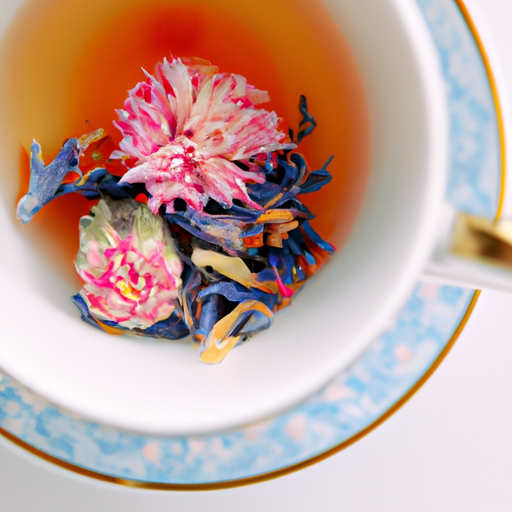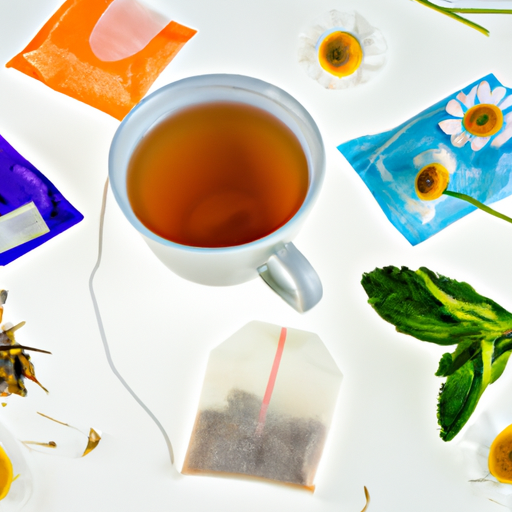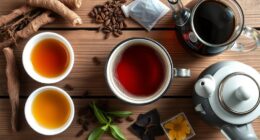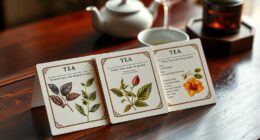Picture this situation: You’ve had a hectic day at work, and all you crave is to unwind and de-stress. You grab a cozy cup of tea, and as you savor that initial sip, a sense of tranquility envelops you. That is the magic of chamomile tea.
Chamomile tea, a popular herbal infusion known for its soothing properties, has been used for centuries to promote relaxation and improve overall well-being. Derived from the chamomile flower, this gentle yet powerful herbal tea offers a plethora of health benefits that can enhance your daily life.
In this article, we will explore the origins and history of chamomile tea, delve into its various types and varieties, and discuss how to brew the perfect cup. We will also explore the numerous health benefits associated with chamomile tea and provide tips on how to incorporate it into your daily routine. However, it’s important to be aware of potential precautions and side effects.
So, whether you’re seeking a natural remedy for stress, a bedtime ritual to promote sleep, or simply a delightful beverage to enjoy, chamomile tea might just be the herbal infusion you’ve been looking for.
Let’s dive in and discover the wonders of chamomile tea together.
Key Takeaways
- Chamomile tea is a popular herbal infusion known for its soothing properties and has been used for centuries to promote relaxation and improve overall well-being.
- Chamomile tea offers a plethora of health benefits, including relieving digestive issues, boosting the immune system, and promoting better sleep.
- There are different types and varieties of chamomile tea, including German, Roman, and Egyptian chamomile, each with their own unique properties and flavors.
- It is important to take precautions for individuals with known allergies to plants like ragweed, daisies, or marigolds, and to be aware of potential interactions with certain medications.
Origins and History of Chamomile Tea
Did you know that chamomile tea has a fascinating history and origin story? Chamomile tea has its origins in Ancient Egypt, where it was used for medicinal purposes. It was considered a sacred herb and was dedicated to the sun god, Ra. The ancient Egyptians believed that chamomile had healing properties and used it to treat various ailments, including digestive issues and insomnia.
From Egypt, chamomile tea spread to other parts of the world, including Europe and Asia. It became a staple in traditional medicine systems such as Ayurveda and Traditional Chinese Medicine. Chamomile tea was also used for its calming effects and as a natural remedy for anxiety and stress.
Now, let’s dive into the health benefits of chamomile tea and discover how it can improve our well-being.
Health Benefits of Chamomile Tea
Surprisingly, chamomile tea offers a multitude of health perks that may leave you feeling pleasantly astonished. This herbal infusion has been used for centuries for its medicinal properties. Here are some of the health benefits associated with chamomile tea:
-
Promotes better sleep: Chamomile tea has a soothing effect that can help improve sleep quality and alleviate insomnia.
-
Reduces anxiety and stress: The tea contains compounds that can help relax the mind and body, reducing feelings of anxiety and stress.
-
Relieves digestive issues: Chamomile tea has been shown to ease digestive discomfort, including bloating, cramps, and indigestion.
-
Boosts immune system: The tea is rich in antioxidants, which can help strengthen the immune system and protect against infections.
These are just a few of the many health benefits that chamomile tea provides.
In the next section, we will explore the different types and varieties of chamomile tea.
Types and Varieties of Chamomile Tea
One can find a variety of options when it comes to enjoying the benefits of chamomile tea. There are several varieties and flavors of chamomile tea available, each with its own unique taste and aroma.
Some popular options include German chamomile, Roman chamomile, and Egyptian chamomile. German chamomile is known for its soothing and calming properties, while Roman chamomile has a milder, sweeter flavor. Egyptian chamomile is often used for its strong floral fragrance.
When looking to purchase chamomile tea, some of the best brands to consider are Traditional Medicinals, Celestial Seasonings, and Bigelow. These brands offer high-quality chamomile tea that’s both flavorful and aromatic.
Now, let’s move on to the next section and discover how to brew the perfect cup of chamomile tea.
How to Brew the Perfect Cup of Chamomile Tea
To brew the perfect cup of chamomile tea, all you need is some hot water, a tea bag, and a touch of honey for an explosion of relaxation in your mouth. Chamomile tea is known for its soothing properties and delicate floral flavor.
Here are some brewing techniques and chamomile tea recipes to enhance your tea-drinking experience:
- Steep the tea bag in hot water for 5-7 minutes to extract the full flavor.
- For a stronger brew, use two tea bags or steep for a longer time.
- Add a splash of lemon juice for a refreshing twist.
- Experiment with different sweeteners like stevia or agave syrup for a personalized taste.
Incorporating chamomile tea into your daily routine can promote relaxation and overall well-being. So, start your day with a calming cup of chamomile tea and let its soothing effects carry you through the day.
Incorporating Chamomile Tea into Your Daily Routine
Start your day off with a warm and comforting cup of chamomile tea, allowing its soothing properties to envelop you in a state of relaxation and well-being.
Chamomile tea has long been recognized as a natural sleep aid, promoting a restful night’s sleep with its calming effects on the mind and body.
But did you know that chamomile tea can also be incorporated into your skincare routine? Its anti-inflammatory and antibacterial properties make it a gentle and effective remedy for various skin issues, such as acne, eczema, and irritation.
Whether you choose to drink it or apply it topically, chamomile tea can work wonders for your overall health and wellness.
However, it’s important to be aware of any precautions and possible side effects of chamomile tea, which we will explore in the next section.
Precautions and Side Effects of Chamomile Tea
Be mindful of potential precautions and side effects when incorporating this soothing beverage into your daily routine. While chamomile tea is generally safe for most people, it’s important to note that some individuals may experience allergic reactions to chamomile. If you have known allergies to plants such as ragweed, daisies, or marigolds, it’s advised to avoid chamomile tea. Additionally, chamomile tea may interact with certain medications, particularly those that affect blood clotting or sedatives. It’s recommended to consult with your healthcare provider if you are taking any medications to ensure there are no potential adverse effects.
To help you better understand the precautions and potential drug interactions with chamomile tea, I have provided a table below:
| Potential Allergies | Drug Interactions |
|---|---|
| Ragweed | Blood-thinning medications |
| Daisies | Sedatives |
| Marigolds |
By being aware of these precautions and potential interactions, you can safely incorporate chamomile tea into your daily routine. In the next section, we will explore the benefits of chamomile tea and how it can enhance your overall well-being.
Conclusion: Embracing the Benefits of Chamomile Tea
After discussing the precautions and side effects of chamomile tea, it’s clear that when consumed responsibly, chamomile tea can be a safe and beneficial herbal remedy. Now, let’s delve into the importance of quality chamomile tea and its role in promoting relaxation and sleep.
When it comes to chamomile tea, quality matters. Opting for organic chamomile tea ensures that you’re getting the purest form of this herbal remedy, free from pesticides and other harmful substances. This guarantees that you’re reaping all the potential benefits chamomile tea has to offer.
One of the key benefits of chamomile tea is its ability to promote relaxation and improve sleep quality. The natural compounds found in chamomile have calming properties that can help reduce anxiety and induce a sense of tranquility. Sipping on a warm cup of chamomile tea before bedtime can be a soothing ritual that aids in unwinding and preparing your body for a restful night’s sleep. Embracing the benefits of chamomile tea can be a simple and effective way to enhance your overall well-being.
Frequently Asked Questions
Can chamomile tea help with anxiety and stress?
Yes, chamomile tea can help with anxiety and stress. Research shows that the natural compounds in chamomile have a calming effect on the body, reducing symptoms of anxiety and promoting relaxation.
Is chamomile tea safe to consume during pregnancy?
Chamomile tea can provide benefits for pregnant women, such as reducing anxiety and promoting better sleep. However, it’s important to take precautions, such as consulting with a healthcare professional and consuming it in moderation to ensure safety during pregnancy.
What is the recommended dosage of chamomile tea for promoting sleep?
The recommended dosage of chamomile tea for promoting sleep is 1-2 cups before bedtime. However, it’s important to note that excessive consumption may lead to potential side effects such as drowsiness and allergic reactions.
Can chamomile tea help with digestive issues like bloating and indigestion?
Yes, chamomile tea can help with digestive issues like bloating and indigestion. It has been shown to have anti-inflammatory properties that can soothe the digestive system. Additionally, chamomile tea is also known for its potential benefits for weight loss and skin health.
Are there any known interactions between chamomile tea and certain medications?
Chamomile tea may interact with anticoagulant medications, increasing the risk of bleeding. Some individuals may also experience allergic reactions to chamomile tea. Remember, "prevention is better than cure."
Conclusion
In conclusion, chamomile tea is a treasure trove of tranquility and therapeutic benefits. Its soothing properties and delicate floral flavor make it a remarkable remedy for stress and anxiety. The calming effects of chamomile tea can be attributed to its natural compounds, such as apigenin and bisabolol, which promote relaxation and sleep.
Moreover, this herbal elixir is a testament to tradition, with a rich history dating back centuries. So sip on this serene potion, and let the power of chamomile transport you to a state of blissful calm.










